Customer Value Management Report: Home Base Customer Value
VerifiedAdded on 2020/10/22
|15
|4903
|308
Report
AI Summary
This report delves into customer value management (CVM), focusing on its significance for businesses, particularly in the context of a home-based organization. It analyzes the components essential for determining and evaluating customer lifetime value (CLV), emphasizing the benefits of CLV for companies like Home Base. The report identifies factors influencing CLV, such as buying behavior and customer perceptions, and explores various market segmentation strategies. Furthermore, it evaluates B2C and B2B decision-making models, demonstrating opportunities for customer value creation. The report also examines techniques for enhancing customer relationships and provides an in-depth analysis of methods to increase customer value. It highlights the importance of customer satisfaction, loyalty, and the impact of various factors, including product quality and economic conditions, on customer value.
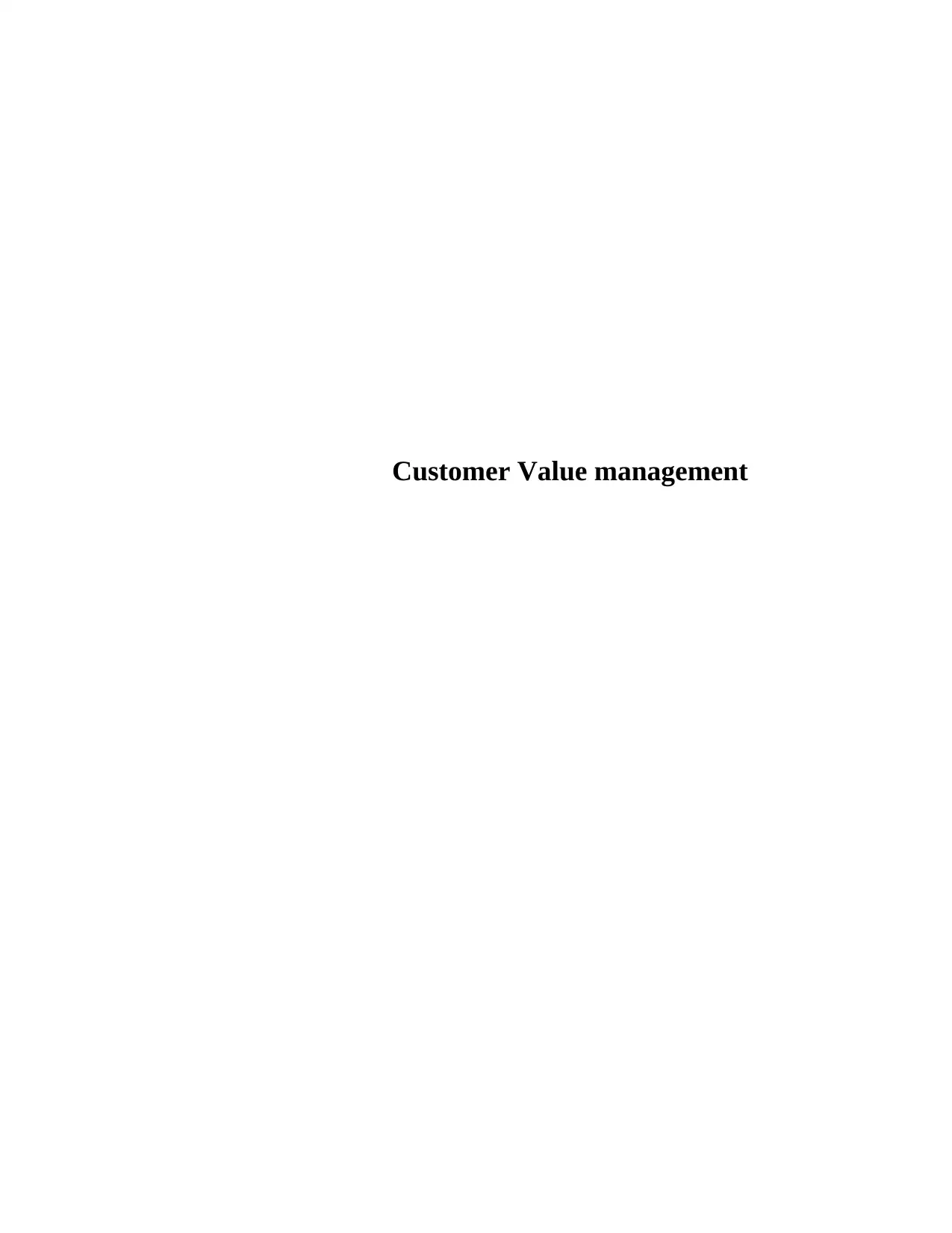
Customer Value management
Paraphrase This Document
Need a fresh take? Get an instant paraphrase of this document with our AI Paraphraser
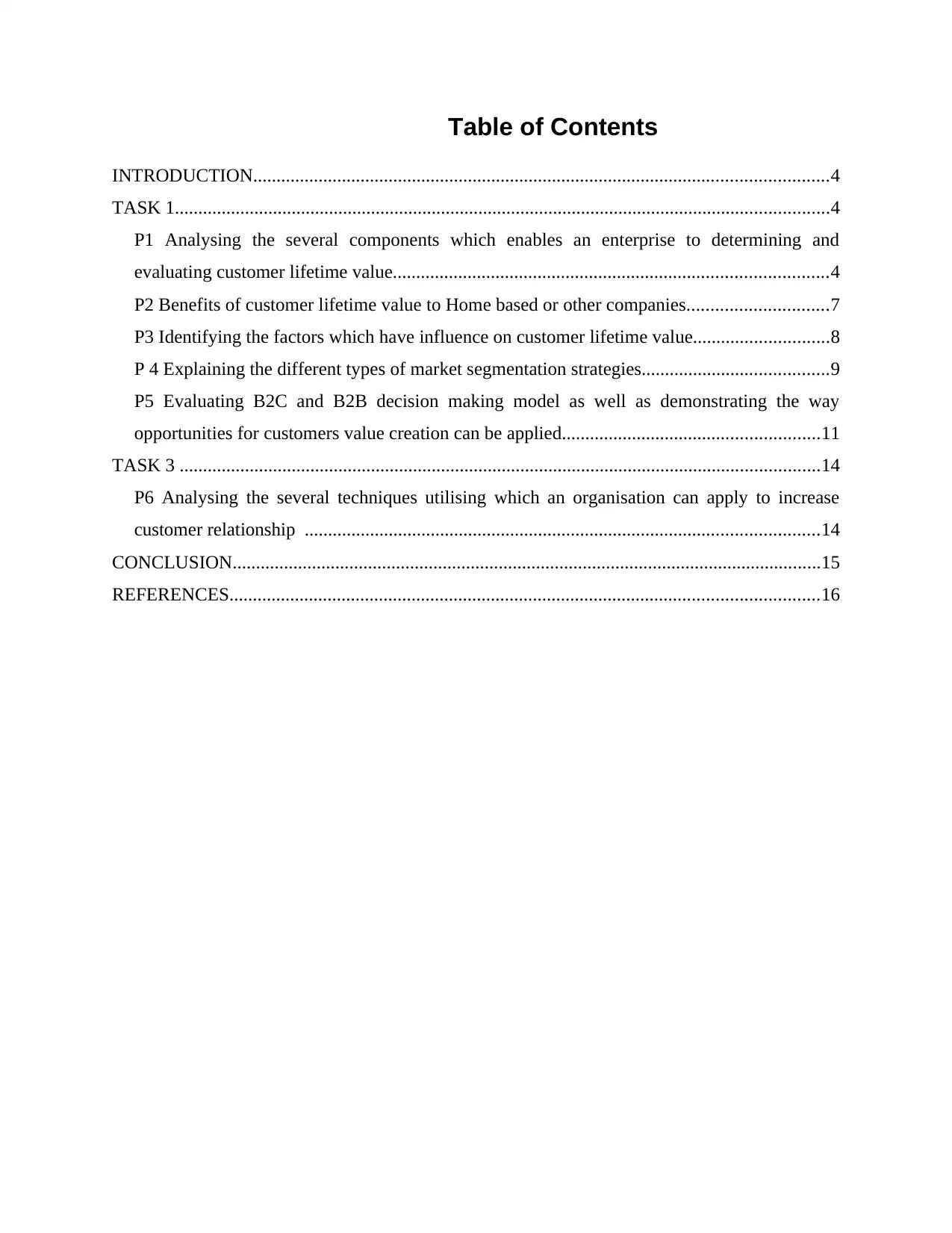
Table of Contents
INTRODUCTION...........................................................................................................................4
TASK 1............................................................................................................................................4
P1 Analysing the several components which enables an enterprise to determining and
evaluating customer lifetime value.............................................................................................4
P2 Benefits of customer lifetime value to Home based or other companies..............................7
P3 Identifying the factors which have influence on customer lifetime value.............................8
P 4 Explaining the different types of market segmentation strategies........................................9
P5 Evaluating B2C and B2B decision making model as well as demonstrating the way
opportunities for customers value creation can be applied.......................................................11
TASK 3 .........................................................................................................................................14
P6 Analysing the several techniques utilising which an organisation can apply to increase
customer relationship ..............................................................................................................14
CONCLUSION..............................................................................................................................15
REFERENCES..............................................................................................................................16
INTRODUCTION...........................................................................................................................4
TASK 1............................................................................................................................................4
P1 Analysing the several components which enables an enterprise to determining and
evaluating customer lifetime value.............................................................................................4
P2 Benefits of customer lifetime value to Home based or other companies..............................7
P3 Identifying the factors which have influence on customer lifetime value.............................8
P 4 Explaining the different types of market segmentation strategies........................................9
P5 Evaluating B2C and B2B decision making model as well as demonstrating the way
opportunities for customers value creation can be applied.......................................................11
TASK 3 .........................................................................................................................................14
P6 Analysing the several techniques utilising which an organisation can apply to increase
customer relationship ..............................................................................................................14
CONCLUSION..............................................................................................................................15
REFERENCES..............................................................................................................................16
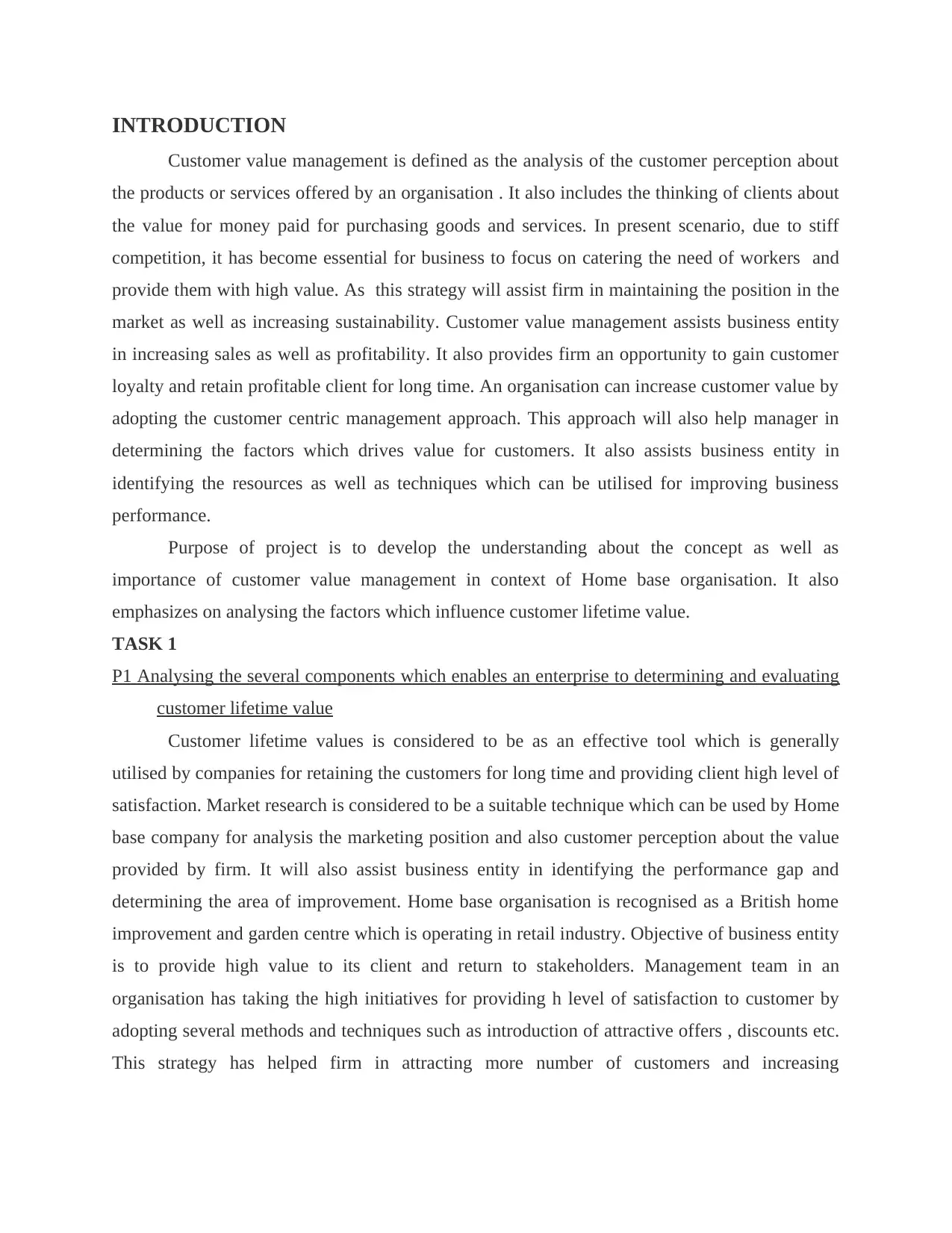
INTRODUCTION
Customer value management is defined as the analysis of the customer perception about
the products or services offered by an organisation . It also includes the thinking of clients about
the value for money paid for purchasing goods and services. In present scenario, due to stiff
competition, it has become essential for business to focus on catering the need of workers and
provide them with high value. As this strategy will assist firm in maintaining the position in the
market as well as increasing sustainability. Customer value management assists business entity
in increasing sales as well as profitability. It also provides firm an opportunity to gain customer
loyalty and retain profitable client for long time. An organisation can increase customer value by
adopting the customer centric management approach. This approach will also help manager in
determining the factors which drives value for customers. It also assists business entity in
identifying the resources as well as techniques which can be utilised for improving business
performance.
Purpose of project is to develop the understanding about the concept as well as
importance of customer value management in context of Home base organisation. It also
emphasizes on analysing the factors which influence customer lifetime value.
TASK 1
P1 Analysing the several components which enables an enterprise to determining and evaluating
customer lifetime value
Customer lifetime values is considered to be as an effective tool which is generally
utilised by companies for retaining the customers for long time and providing client high level of
satisfaction. Market research is considered to be a suitable technique which can be used by Home
base company for analysis the marketing position and also customer perception about the value
provided by firm. It will also assist business entity in identifying the performance gap and
determining the area of improvement. Home base organisation is recognised as a British home
improvement and garden centre which is operating in retail industry. Objective of business entity
is to provide high value to its client and return to stakeholders. Management team in an
organisation has taking the high initiatives for providing h level of satisfaction to customer by
adopting several methods and techniques such as introduction of attractive offers , discounts etc.
This strategy has helped firm in attracting more number of customers and increasing
Customer value management is defined as the analysis of the customer perception about
the products or services offered by an organisation . It also includes the thinking of clients about
the value for money paid for purchasing goods and services. In present scenario, due to stiff
competition, it has become essential for business to focus on catering the need of workers and
provide them with high value. As this strategy will assist firm in maintaining the position in the
market as well as increasing sustainability. Customer value management assists business entity
in increasing sales as well as profitability. It also provides firm an opportunity to gain customer
loyalty and retain profitable client for long time. An organisation can increase customer value by
adopting the customer centric management approach. This approach will also help manager in
determining the factors which drives value for customers. It also assists business entity in
identifying the resources as well as techniques which can be utilised for improving business
performance.
Purpose of project is to develop the understanding about the concept as well as
importance of customer value management in context of Home base organisation. It also
emphasizes on analysing the factors which influence customer lifetime value.
TASK 1
P1 Analysing the several components which enables an enterprise to determining and evaluating
customer lifetime value
Customer lifetime values is considered to be as an effective tool which is generally
utilised by companies for retaining the customers for long time and providing client high level of
satisfaction. Market research is considered to be a suitable technique which can be used by Home
base company for analysis the marketing position and also customer perception about the value
provided by firm. It will also assist business entity in identifying the performance gap and
determining the area of improvement. Home base organisation is recognised as a British home
improvement and garden centre which is operating in retail industry. Objective of business entity
is to provide high value to its client and return to stakeholders. Management team in an
organisation has taking the high initiatives for providing h level of satisfaction to customer by
adopting several methods and techniques such as introduction of attractive offers , discounts etc.
This strategy has helped firm in attracting more number of customers and increasing
⊘ This is a preview!⊘
Do you want full access?
Subscribe today to unlock all pages.

Trusted by 1+ million students worldwide
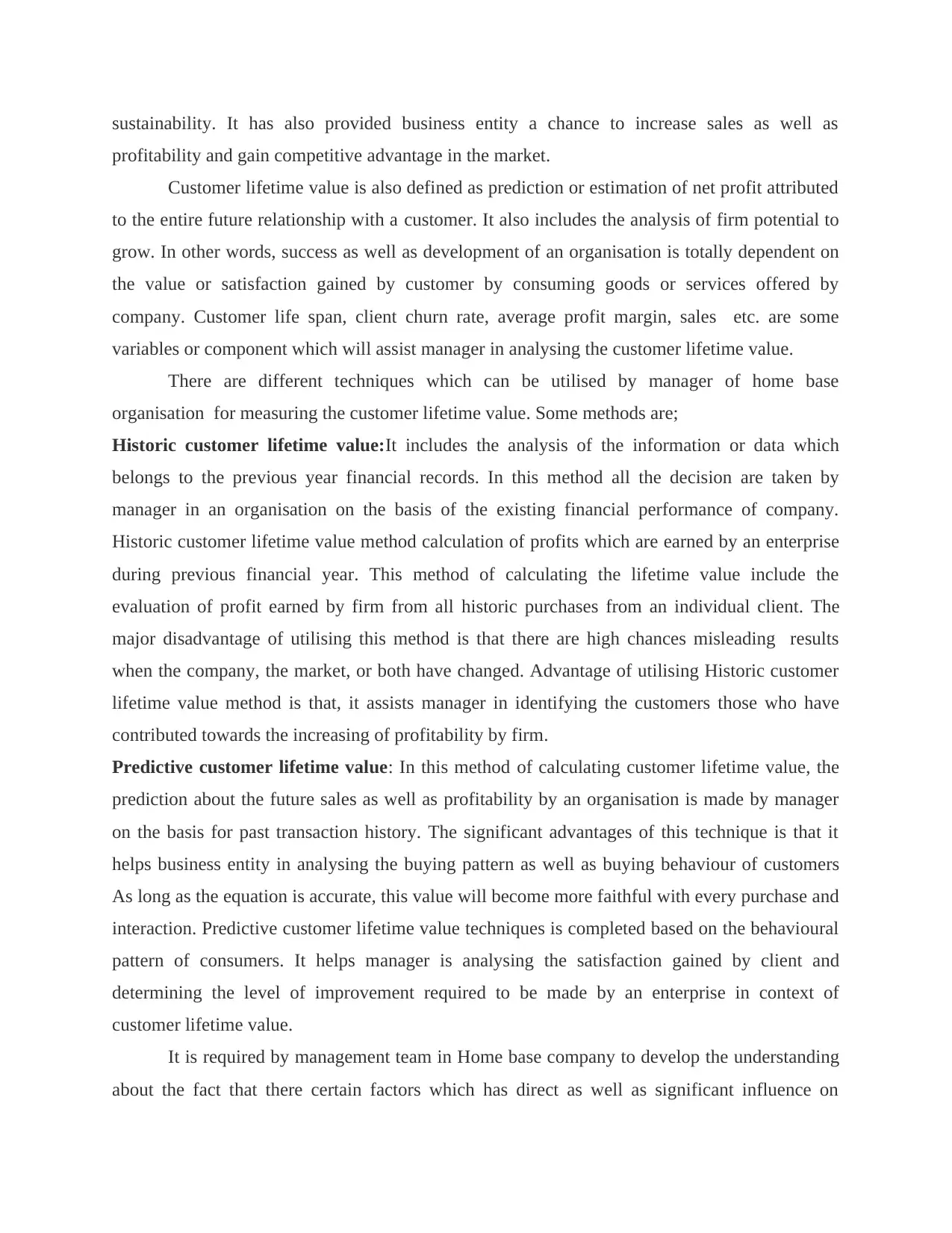
sustainability. It has also provided business entity a chance to increase sales as well as
profitability and gain competitive advantage in the market.
Customer lifetime value is also defined as prediction or estimation of net profit attributed
to the entire future relationship with a customer. It also includes the analysis of firm potential to
grow. In other words, success as well as development of an organisation is totally dependent on
the value or satisfaction gained by customer by consuming goods or services offered by
company. Customer life span, client churn rate, average profit margin, sales etc. are some
variables or component which will assist manager in analysing the customer lifetime value.
There are different techniques which can be utilised by manager of home base
organisation for measuring the customer lifetime value. Some methods are;
Historic customer lifetime value:It includes the analysis of the information or data which
belongs to the previous year financial records. In this method all the decision are taken by
manager in an organisation on the basis of the existing financial performance of company.
Historic customer lifetime value method calculation of profits which are earned by an enterprise
during previous financial year. This method of calculating the lifetime value include the
evaluation of profit earned by firm from all historic purchases from an individual client. The
major disadvantage of utilising this method is that there are high chances misleading results
when the company, the market, or both have changed. Advantage of utilising Historic customer
lifetime value method is that, it assists manager in identifying the customers those who have
contributed towards the increasing of profitability by firm.
Predictive customer lifetime value: In this method of calculating customer lifetime value, the
prediction about the future sales as well as profitability by an organisation is made by manager
on the basis for past transaction history. The significant advantages of this technique is that it
helps business entity in analysing the buying pattern as well as buying behaviour of customers
As long as the equation is accurate, this value will become more faithful with every purchase and
interaction. Predictive customer lifetime value techniques is completed based on the behavioural
pattern of consumers. It helps manager is analysing the satisfaction gained by client and
determining the level of improvement required to be made by an enterprise in context of
customer lifetime value.
It is required by management team in Home base company to develop the understanding
about the fact that there certain factors which has direct as well as significant influence on
profitability and gain competitive advantage in the market.
Customer lifetime value is also defined as prediction or estimation of net profit attributed
to the entire future relationship with a customer. It also includes the analysis of firm potential to
grow. In other words, success as well as development of an organisation is totally dependent on
the value or satisfaction gained by customer by consuming goods or services offered by
company. Customer life span, client churn rate, average profit margin, sales etc. are some
variables or component which will assist manager in analysing the customer lifetime value.
There are different techniques which can be utilised by manager of home base
organisation for measuring the customer lifetime value. Some methods are;
Historic customer lifetime value:It includes the analysis of the information or data which
belongs to the previous year financial records. In this method all the decision are taken by
manager in an organisation on the basis of the existing financial performance of company.
Historic customer lifetime value method calculation of profits which are earned by an enterprise
during previous financial year. This method of calculating the lifetime value include the
evaluation of profit earned by firm from all historic purchases from an individual client. The
major disadvantage of utilising this method is that there are high chances misleading results
when the company, the market, or both have changed. Advantage of utilising Historic customer
lifetime value method is that, it assists manager in identifying the customers those who have
contributed towards the increasing of profitability by firm.
Predictive customer lifetime value: In this method of calculating customer lifetime value, the
prediction about the future sales as well as profitability by an organisation is made by manager
on the basis for past transaction history. The significant advantages of this technique is that it
helps business entity in analysing the buying pattern as well as buying behaviour of customers
As long as the equation is accurate, this value will become more faithful with every purchase and
interaction. Predictive customer lifetime value techniques is completed based on the behavioural
pattern of consumers. It helps manager is analysing the satisfaction gained by client and
determining the level of improvement required to be made by an enterprise in context of
customer lifetime value.
It is required by management team in Home base company to develop the understanding
about the fact that there certain factors which has direct as well as significant influence on
Paraphrase This Document
Need a fresh take? Get an instant paraphrase of this document with our AI Paraphraser
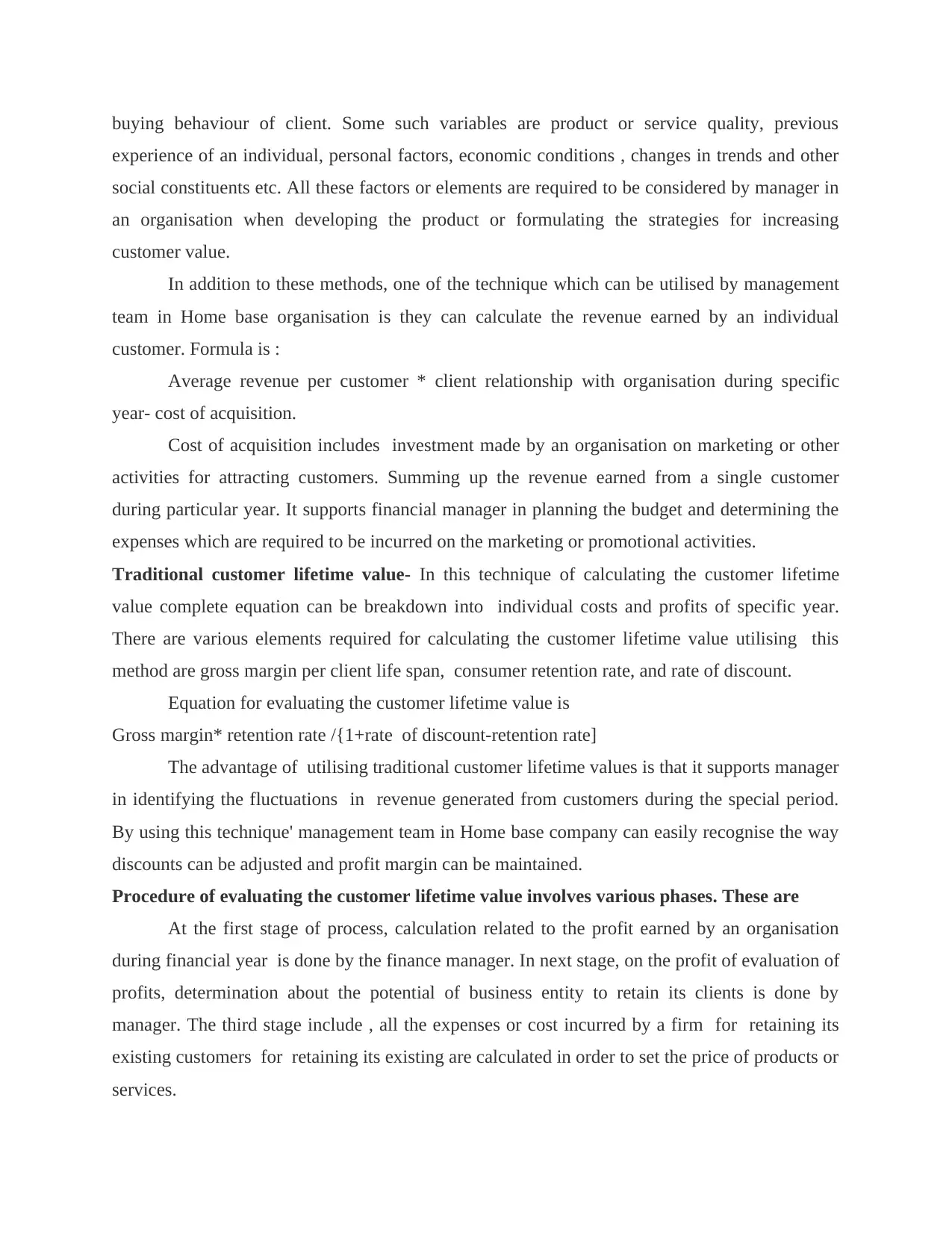
buying behaviour of client. Some such variables are product or service quality, previous
experience of an individual, personal factors, economic conditions , changes in trends and other
social constituents etc. All these factors or elements are required to be considered by manager in
an organisation when developing the product or formulating the strategies for increasing
customer value.
In addition to these methods, one of the technique which can be utilised by management
team in Home base organisation is they can calculate the revenue earned by an individual
customer. Formula is :
Average revenue per customer * client relationship with organisation during specific
year- cost of acquisition.
Cost of acquisition includes investment made by an organisation on marketing or other
activities for attracting customers. Summing up the revenue earned from a single customer
during particular year. It supports financial manager in planning the budget and determining the
expenses which are required to be incurred on the marketing or promotional activities.
Traditional customer lifetime value- In this technique of calculating the customer lifetime
value complete equation can be breakdown into individual costs and profits of specific year.
There are various elements required for calculating the customer lifetime value utilising this
method are gross margin per client life span, consumer retention rate, and rate of discount.
Equation for evaluating the customer lifetime value is
Gross margin* retention rate /{1+rate of discount-retention rate]
The advantage of utilising traditional customer lifetime values is that it supports manager
in identifying the fluctuations in revenue generated from customers during the special period.
By using this technique' management team in Home base company can easily recognise the way
discounts can be adjusted and profit margin can be maintained.
Procedure of evaluating the customer lifetime value involves various phases. These are
At the first stage of process, calculation related to the profit earned by an organisation
during financial year is done by the finance manager. In next stage, on the profit of evaluation of
profits, determination about the potential of business entity to retain its clients is done by
manager. The third stage include , all the expenses or cost incurred by a firm for retaining its
existing customers for retaining its existing are calculated in order to set the price of products or
services.
experience of an individual, personal factors, economic conditions , changes in trends and other
social constituents etc. All these factors or elements are required to be considered by manager in
an organisation when developing the product or formulating the strategies for increasing
customer value.
In addition to these methods, one of the technique which can be utilised by management
team in Home base organisation is they can calculate the revenue earned by an individual
customer. Formula is :
Average revenue per customer * client relationship with organisation during specific
year- cost of acquisition.
Cost of acquisition includes investment made by an organisation on marketing or other
activities for attracting customers. Summing up the revenue earned from a single customer
during particular year. It supports financial manager in planning the budget and determining the
expenses which are required to be incurred on the marketing or promotional activities.
Traditional customer lifetime value- In this technique of calculating the customer lifetime
value complete equation can be breakdown into individual costs and profits of specific year.
There are various elements required for calculating the customer lifetime value utilising this
method are gross margin per client life span, consumer retention rate, and rate of discount.
Equation for evaluating the customer lifetime value is
Gross margin* retention rate /{1+rate of discount-retention rate]
The advantage of utilising traditional customer lifetime values is that it supports manager
in identifying the fluctuations in revenue generated from customers during the special period.
By using this technique' management team in Home base company can easily recognise the way
discounts can be adjusted and profit margin can be maintained.
Procedure of evaluating the customer lifetime value involves various phases. These are
At the first stage of process, calculation related to the profit earned by an organisation
during financial year is done by the finance manager. In next stage, on the profit of evaluation of
profits, determination about the potential of business entity to retain its clients is done by
manager. The third stage include , all the expenses or cost incurred by a firm for retaining its
existing customers for retaining its existing are calculated in order to set the price of products or
services.
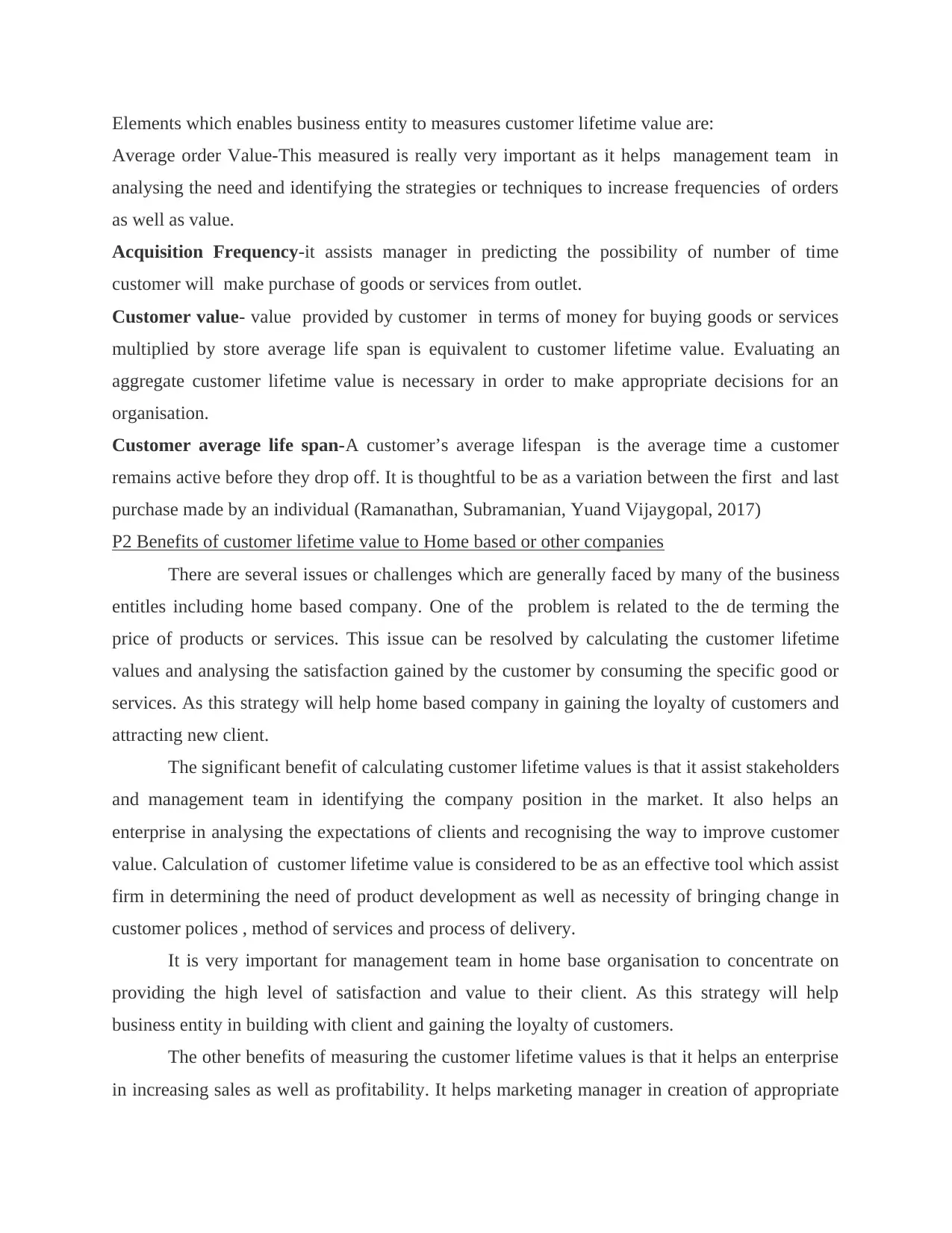
Elements which enables business entity to measures customer lifetime value are:
Average order Value-This measured is really very important as it helps management team in
analysing the need and identifying the strategies or techniques to increase frequencies of orders
as well as value.
Acquisition Frequency-it assists manager in predicting the possibility of number of time
customer will make purchase of goods or services from outlet.
Customer value- value provided by customer in terms of money for buying goods or services
multiplied by store average life span is equivalent to customer lifetime value. Evaluating an
aggregate customer lifetime value is necessary in order to make appropriate decisions for an
organisation.
Customer average life span-A customer’s average lifespan is the average time a customer
remains active before they drop off. It is thoughtful to be as a variation between the first and last
purchase made by an individual (Ramanathan, Subramanian, Yuand Vijaygopal, 2017)
P2 Benefits of customer lifetime value to Home based or other companies
There are several issues or challenges which are generally faced by many of the business
entitles including home based company. One of the problem is related to the de terming the
price of products or services. This issue can be resolved by calculating the customer lifetime
values and analysing the satisfaction gained by the customer by consuming the specific good or
services. As this strategy will help home based company in gaining the loyalty of customers and
attracting new client.
The significant benefit of calculating customer lifetime values is that it assist stakeholders
and management team in identifying the company position in the market. It also helps an
enterprise in analysing the expectations of clients and recognising the way to improve customer
value. Calculation of customer lifetime value is considered to be as an effective tool which assist
firm in determining the need of product development as well as necessity of bringing change in
customer polices , method of services and process of delivery.
It is very important for management team in home base organisation to concentrate on
providing the high level of satisfaction and value to their client. As this strategy will help
business entity in building with client and gaining the loyalty of customers.
The other benefits of measuring the customer lifetime values is that it helps an enterprise
in increasing sales as well as profitability. It helps marketing manager in creation of appropriate
Average order Value-This measured is really very important as it helps management team in
analysing the need and identifying the strategies or techniques to increase frequencies of orders
as well as value.
Acquisition Frequency-it assists manager in predicting the possibility of number of time
customer will make purchase of goods or services from outlet.
Customer value- value provided by customer in terms of money for buying goods or services
multiplied by store average life span is equivalent to customer lifetime value. Evaluating an
aggregate customer lifetime value is necessary in order to make appropriate decisions for an
organisation.
Customer average life span-A customer’s average lifespan is the average time a customer
remains active before they drop off. It is thoughtful to be as a variation between the first and last
purchase made by an individual (Ramanathan, Subramanian, Yuand Vijaygopal, 2017)
P2 Benefits of customer lifetime value to Home based or other companies
There are several issues or challenges which are generally faced by many of the business
entitles including home based company. One of the problem is related to the de terming the
price of products or services. This issue can be resolved by calculating the customer lifetime
values and analysing the satisfaction gained by the customer by consuming the specific good or
services. As this strategy will help home based company in gaining the loyalty of customers and
attracting new client.
The significant benefit of calculating customer lifetime values is that it assist stakeholders
and management team in identifying the company position in the market. It also helps an
enterprise in analysing the expectations of clients and recognising the way to improve customer
value. Calculation of customer lifetime value is considered to be as an effective tool which assist
firm in determining the need of product development as well as necessity of bringing change in
customer polices , method of services and process of delivery.
It is very important for management team in home base organisation to concentrate on
providing the high level of satisfaction and value to their client. As this strategy will help
business entity in building with client and gaining the loyalty of customers.
The other benefits of measuring the customer lifetime values is that it helps an enterprise
in increasing sales as well as profitability. It helps marketing manager in creation of appropriate
⊘ This is a preview!⊘
Do you want full access?
Subscribe today to unlock all pages.

Trusted by 1+ million students worldwide
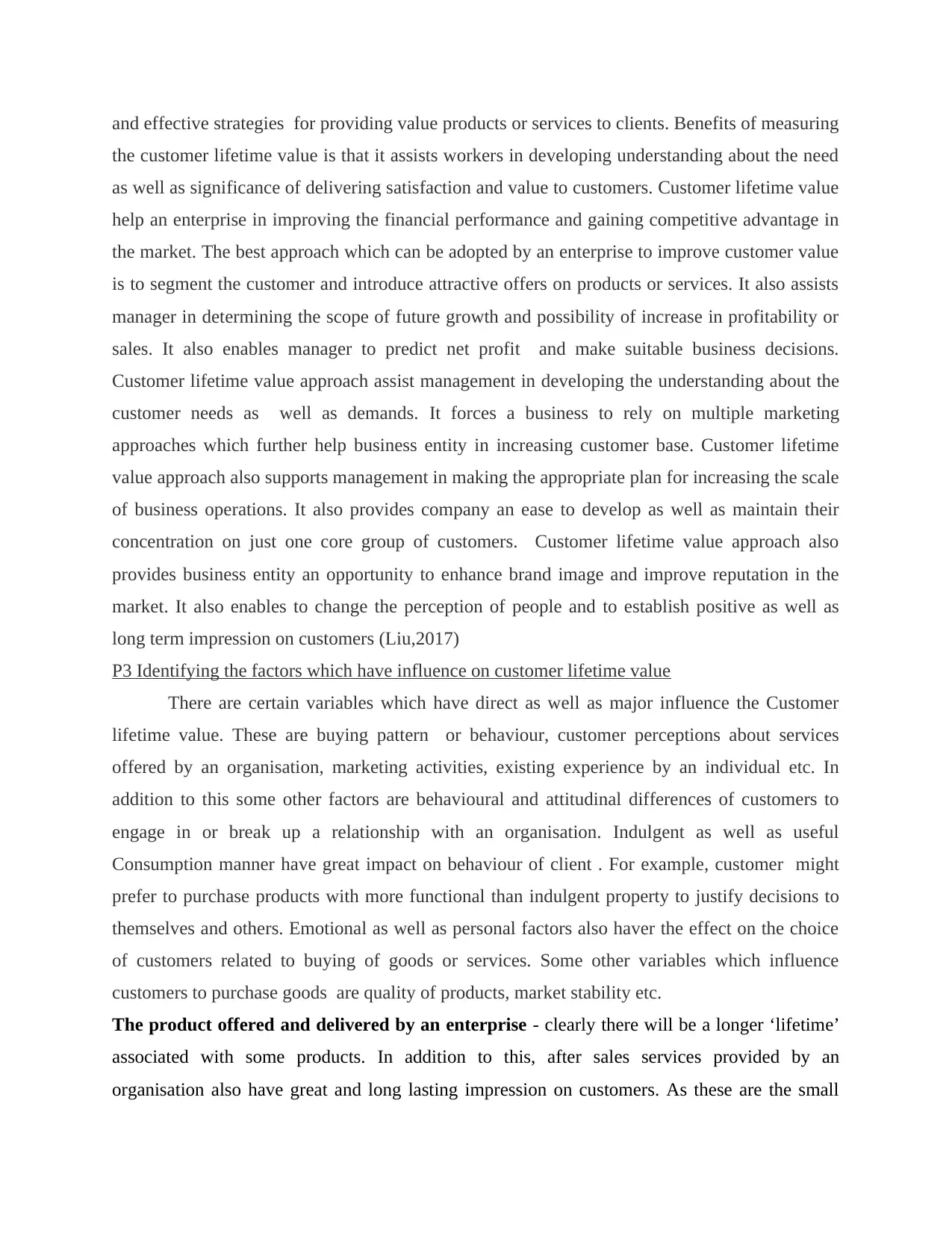
and effective strategies for providing value products or services to clients. Benefits of measuring
the customer lifetime value is that it assists workers in developing understanding about the need
as well as significance of delivering satisfaction and value to customers. Customer lifetime value
help an enterprise in improving the financial performance and gaining competitive advantage in
the market. The best approach which can be adopted by an enterprise to improve customer value
is to segment the customer and introduce attractive offers on products or services. It also assists
manager in determining the scope of future growth and possibility of increase in profitability or
sales. It also enables manager to predict net profit and make suitable business decisions.
Customer lifetime value approach assist management in developing the understanding about the
customer needs as well as demands. It forces a business to rely on multiple marketing
approaches which further help business entity in increasing customer base. Customer lifetime
value approach also supports management in making the appropriate plan for increasing the scale
of business operations. It also provides company an ease to develop as well as maintain their
concentration on just one core group of customers. Customer lifetime value approach also
provides business entity an opportunity to enhance brand image and improve reputation in the
market. It also enables to change the perception of people and to establish positive as well as
long term impression on customers (Liu,2017)
P3 Identifying the factors which have influence on customer lifetime value
There are certain variables which have direct as well as major influence the Customer
lifetime value. These are buying pattern or behaviour, customer perceptions about services
offered by an organisation, marketing activities, existing experience by an individual etc. In
addition to this some other factors are behavioural and attitudinal differences of customers to
engage in or break up a relationship with an organisation. Indulgent as well as useful
Consumption manner have great impact on behaviour of client . For example, customer might
prefer to purchase products with more functional than indulgent property to justify decisions to
themselves and others. Emotional as well as personal factors also haver the effect on the choice
of customers related to buying of goods or services. Some other variables which influence
customers to purchase goods are quality of products, market stability etc.
The product offered and delivered by an enterprise - clearly there will be a longer ‘lifetime’
associated with some products. In addition to this, after sales services provided by an
organisation also have great and long lasting impression on customers. As these are the small
the customer lifetime value is that it assists workers in developing understanding about the need
as well as significance of delivering satisfaction and value to customers. Customer lifetime value
help an enterprise in improving the financial performance and gaining competitive advantage in
the market. The best approach which can be adopted by an enterprise to improve customer value
is to segment the customer and introduce attractive offers on products or services. It also assists
manager in determining the scope of future growth and possibility of increase in profitability or
sales. It also enables manager to predict net profit and make suitable business decisions.
Customer lifetime value approach assist management in developing the understanding about the
customer needs as well as demands. It forces a business to rely on multiple marketing
approaches which further help business entity in increasing customer base. Customer lifetime
value approach also supports management in making the appropriate plan for increasing the scale
of business operations. It also provides company an ease to develop as well as maintain their
concentration on just one core group of customers. Customer lifetime value approach also
provides business entity an opportunity to enhance brand image and improve reputation in the
market. It also enables to change the perception of people and to establish positive as well as
long term impression on customers (Liu,2017)
P3 Identifying the factors which have influence on customer lifetime value
There are certain variables which have direct as well as major influence the Customer
lifetime value. These are buying pattern or behaviour, customer perceptions about services
offered by an organisation, marketing activities, existing experience by an individual etc. In
addition to this some other factors are behavioural and attitudinal differences of customers to
engage in or break up a relationship with an organisation. Indulgent as well as useful
Consumption manner have great impact on behaviour of client . For example, customer might
prefer to purchase products with more functional than indulgent property to justify decisions to
themselves and others. Emotional as well as personal factors also haver the effect on the choice
of customers related to buying of goods or services. Some other variables which influence
customers to purchase goods are quality of products, market stability etc.
The product offered and delivered by an enterprise - clearly there will be a longer ‘lifetime’
associated with some products. In addition to this, after sales services provided by an
organisation also have great and long lasting impression on customers. As these are the small
Paraphrase This Document
Need a fresh take? Get an instant paraphrase of this document with our AI Paraphraser
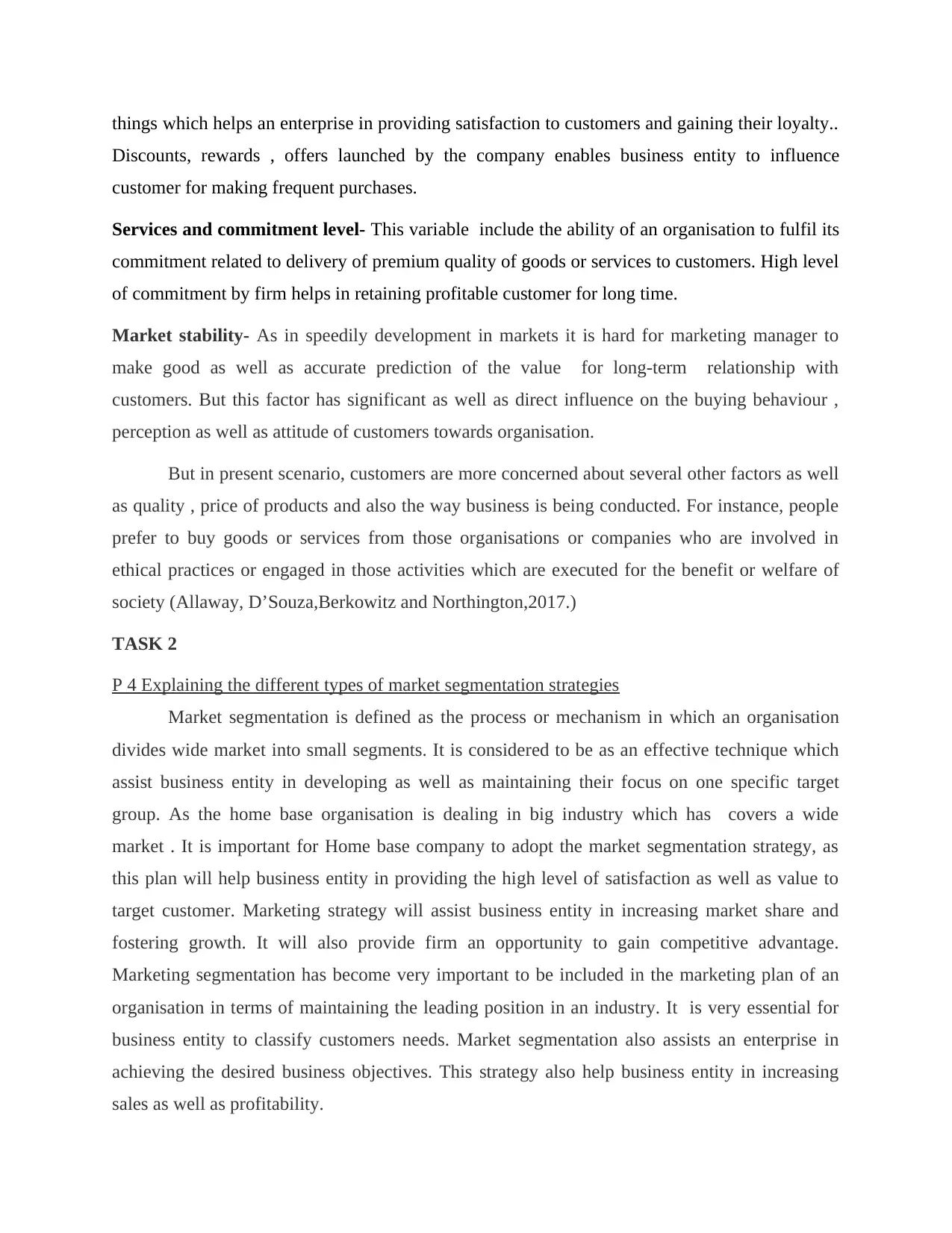
things which helps an enterprise in providing satisfaction to customers and gaining their loyalty..
Discounts, rewards , offers launched by the company enables business entity to influence
customer for making frequent purchases.
Services and commitment level- This variable include the ability of an organisation to fulfil its
commitment related to delivery of premium quality of goods or services to customers. High level
of commitment by firm helps in retaining profitable customer for long time.
Market stability- As in speedily development in markets it is hard for marketing manager to
make good as well as accurate prediction of the value for long-term relationship with
customers. But this factor has significant as well as direct influence on the buying behaviour ,
perception as well as attitude of customers towards organisation.
But in present scenario, customers are more concerned about several other factors as well
as quality , price of products and also the way business is being conducted. For instance, people
prefer to buy goods or services from those organisations or companies who are involved in
ethical practices or engaged in those activities which are executed for the benefit or welfare of
society (Allaway, D’Souza,Berkowitz and Northington,2017.)
TASK 2
P 4 Explaining the different types of market segmentation strategies
Market segmentation is defined as the process or mechanism in which an organisation
divides wide market into small segments. It is considered to be as an effective technique which
assist business entity in developing as well as maintaining their focus on one specific target
group. As the home base organisation is dealing in big industry which has covers a wide
market . It is important for Home base company to adopt the market segmentation strategy, as
this plan will help business entity in providing the high level of satisfaction as well as value to
target customer. Marketing strategy will assist business entity in increasing market share and
fostering growth. It will also provide firm an opportunity to gain competitive advantage.
Marketing segmentation has become very important to be included in the marketing plan of an
organisation in terms of maintaining the leading position in an industry. It is very essential for
business entity to classify customers needs. Market segmentation also assists an enterprise in
achieving the desired business objectives. This strategy also help business entity in increasing
sales as well as profitability.
Discounts, rewards , offers launched by the company enables business entity to influence
customer for making frequent purchases.
Services and commitment level- This variable include the ability of an organisation to fulfil its
commitment related to delivery of premium quality of goods or services to customers. High level
of commitment by firm helps in retaining profitable customer for long time.
Market stability- As in speedily development in markets it is hard for marketing manager to
make good as well as accurate prediction of the value for long-term relationship with
customers. But this factor has significant as well as direct influence on the buying behaviour ,
perception as well as attitude of customers towards organisation.
But in present scenario, customers are more concerned about several other factors as well
as quality , price of products and also the way business is being conducted. For instance, people
prefer to buy goods or services from those organisations or companies who are involved in
ethical practices or engaged in those activities which are executed for the benefit or welfare of
society (Allaway, D’Souza,Berkowitz and Northington,2017.)
TASK 2
P 4 Explaining the different types of market segmentation strategies
Market segmentation is defined as the process or mechanism in which an organisation
divides wide market into small segments. It is considered to be as an effective technique which
assist business entity in developing as well as maintaining their focus on one specific target
group. As the home base organisation is dealing in big industry which has covers a wide
market . It is important for Home base company to adopt the market segmentation strategy, as
this plan will help business entity in providing the high level of satisfaction as well as value to
target customer. Marketing strategy will assist business entity in increasing market share and
fostering growth. It will also provide firm an opportunity to gain competitive advantage.
Marketing segmentation has become very important to be included in the marketing plan of an
organisation in terms of maintaining the leading position in an industry. It is very essential for
business entity to classify customers needs. Market segmentation also assists an enterprise in
achieving the desired business objectives. This strategy also help business entity in increasing
sales as well as profitability.
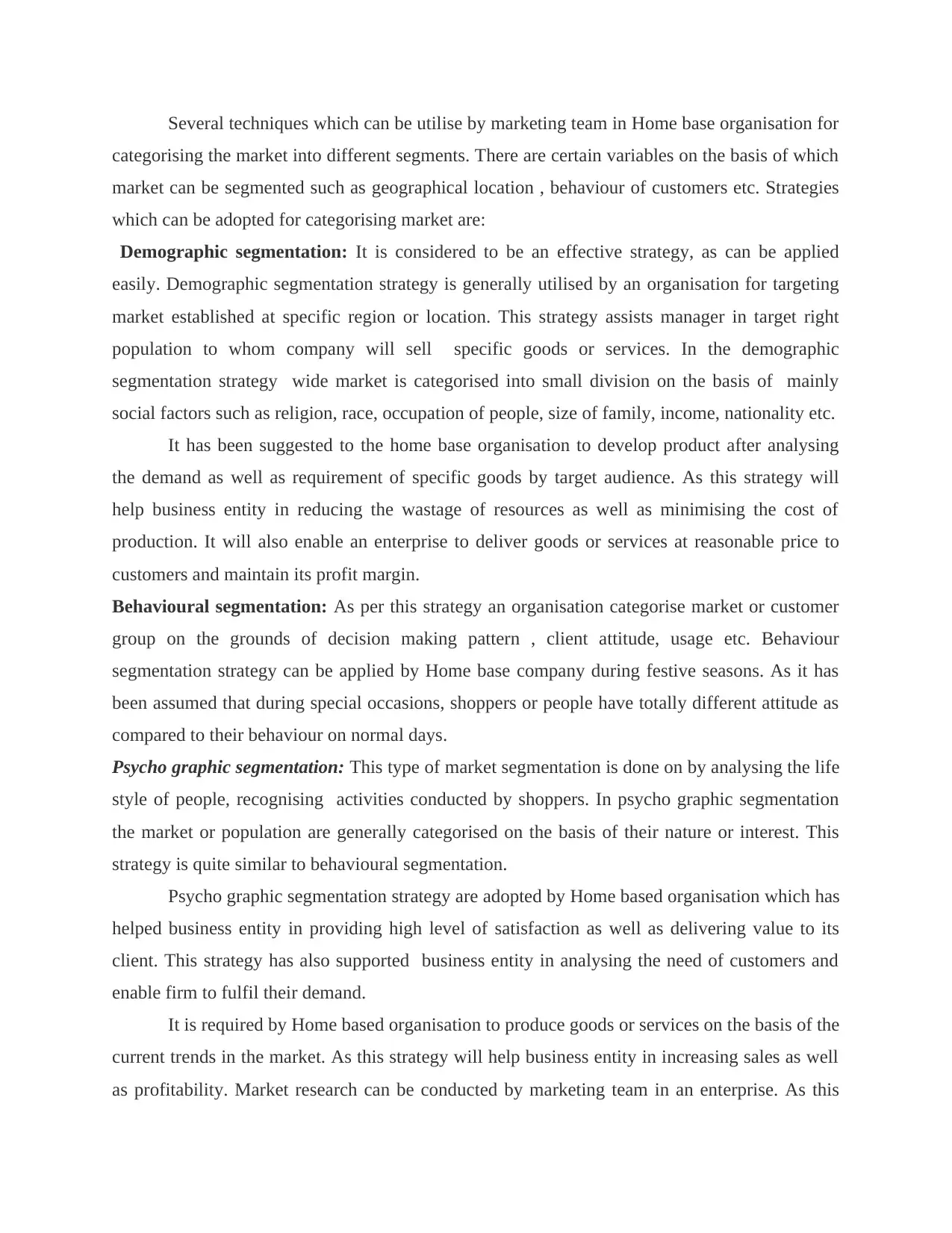
Several techniques which can be utilise by marketing team in Home base organisation for
categorising the market into different segments. There are certain variables on the basis of which
market can be segmented such as geographical location , behaviour of customers etc. Strategies
which can be adopted for categorising market are:
Demographic segmentation: It is considered to be an effective strategy, as can be applied
easily. Demographic segmentation strategy is generally utilised by an organisation for targeting
market established at specific region or location. This strategy assists manager in target right
population to whom company will sell specific goods or services. In the demographic
segmentation strategy wide market is categorised into small division on the basis of mainly
social factors such as religion, race, occupation of people, size of family, income, nationality etc.
It has been suggested to the home base organisation to develop product after analysing
the demand as well as requirement of specific goods by target audience. As this strategy will
help business entity in reducing the wastage of resources as well as minimising the cost of
production. It will also enable an enterprise to deliver goods or services at reasonable price to
customers and maintain its profit margin.
Behavioural segmentation: As per this strategy an organisation categorise market or customer
group on the grounds of decision making pattern , client attitude, usage etc. Behaviour
segmentation strategy can be applied by Home base company during festive seasons. As it has
been assumed that during special occasions, shoppers or people have totally different attitude as
compared to their behaviour on normal days.
Psycho graphic segmentation: This type of market segmentation is done on by analysing the life
style of people, recognising activities conducted by shoppers. In psycho graphic segmentation
the market or population are generally categorised on the basis of their nature or interest. This
strategy is quite similar to behavioural segmentation.
Psycho graphic segmentation strategy are adopted by Home based organisation which has
helped business entity in providing high level of satisfaction as well as delivering value to its
client. This strategy has also supported business entity in analysing the need of customers and
enable firm to fulfil their demand.
It is required by Home based organisation to produce goods or services on the basis of the
current trends in the market. As this strategy will help business entity in increasing sales as well
as profitability. Market research can be conducted by marketing team in an enterprise. As this
categorising the market into different segments. There are certain variables on the basis of which
market can be segmented such as geographical location , behaviour of customers etc. Strategies
which can be adopted for categorising market are:
Demographic segmentation: It is considered to be an effective strategy, as can be applied
easily. Demographic segmentation strategy is generally utilised by an organisation for targeting
market established at specific region or location. This strategy assists manager in target right
population to whom company will sell specific goods or services. In the demographic
segmentation strategy wide market is categorised into small division on the basis of mainly
social factors such as religion, race, occupation of people, size of family, income, nationality etc.
It has been suggested to the home base organisation to develop product after analysing
the demand as well as requirement of specific goods by target audience. As this strategy will
help business entity in reducing the wastage of resources as well as minimising the cost of
production. It will also enable an enterprise to deliver goods or services at reasonable price to
customers and maintain its profit margin.
Behavioural segmentation: As per this strategy an organisation categorise market or customer
group on the grounds of decision making pattern , client attitude, usage etc. Behaviour
segmentation strategy can be applied by Home base company during festive seasons. As it has
been assumed that during special occasions, shoppers or people have totally different attitude as
compared to their behaviour on normal days.
Psycho graphic segmentation: This type of market segmentation is done on by analysing the life
style of people, recognising activities conducted by shoppers. In psycho graphic segmentation
the market or population are generally categorised on the basis of their nature or interest. This
strategy is quite similar to behavioural segmentation.
Psycho graphic segmentation strategy are adopted by Home based organisation which has
helped business entity in providing high level of satisfaction as well as delivering value to its
client. This strategy has also supported business entity in analysing the need of customers and
enable firm to fulfil their demand.
It is required by Home based organisation to produce goods or services on the basis of the
current trends in the market. As this strategy will help business entity in increasing sales as well
as profitability. Market research can be conducted by marketing team in an enterprise. As this
⊘ This is a preview!⊘
Do you want full access?
Subscribe today to unlock all pages.

Trusted by 1+ million students worldwide
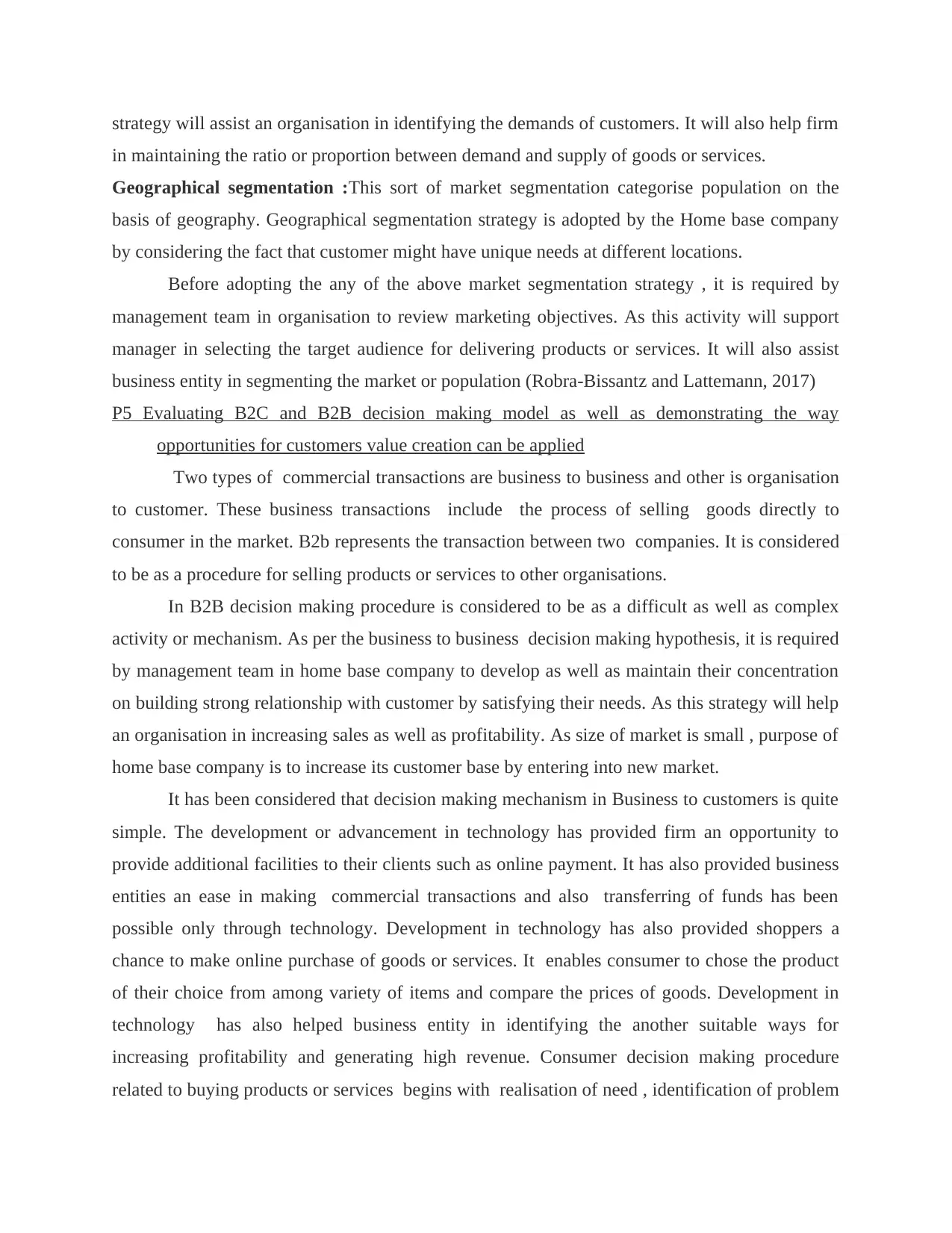
strategy will assist an organisation in identifying the demands of customers. It will also help firm
in maintaining the ratio or proportion between demand and supply of goods or services.
Geographical segmentation :This sort of market segmentation categorise population on the
basis of geography. Geographical segmentation strategy is adopted by the Home base company
by considering the fact that customer might have unique needs at different locations.
Before adopting the any of the above market segmentation strategy , it is required by
management team in organisation to review marketing objectives. As this activity will support
manager in selecting the target audience for delivering products or services. It will also assist
business entity in segmenting the market or population (Robra-Bissantz and Lattemann, 2017)
P5 Evaluating B2C and B2B decision making model as well as demonstrating the way
opportunities for customers value creation can be applied
Two types of commercial transactions are business to business and other is organisation
to customer. These business transactions include the process of selling goods directly to
consumer in the market. B2b represents the transaction between two companies. It is considered
to be as a procedure for selling products or services to other organisations.
In B2B decision making procedure is considered to be as a difficult as well as complex
activity or mechanism. As per the business to business decision making hypothesis, it is required
by management team in home base company to develop as well as maintain their concentration
on building strong relationship with customer by satisfying their needs. As this strategy will help
an organisation in increasing sales as well as profitability. As size of market is small , purpose of
home base company is to increase its customer base by entering into new market.
It has been considered that decision making mechanism in Business to customers is quite
simple. The development or advancement in technology has provided firm an opportunity to
provide additional facilities to their clients such as online payment. It has also provided business
entities an ease in making commercial transactions and also transferring of funds has been
possible only through technology. Development in technology has also provided shoppers a
chance to make online purchase of goods or services. It enables consumer to chose the product
of their choice from among variety of items and compare the prices of goods. Development in
technology has also helped business entity in identifying the another suitable ways for
increasing profitability and generating high revenue. Consumer decision making procedure
related to buying products or services begins with realisation of need , identification of problem
in maintaining the ratio or proportion between demand and supply of goods or services.
Geographical segmentation :This sort of market segmentation categorise population on the
basis of geography. Geographical segmentation strategy is adopted by the Home base company
by considering the fact that customer might have unique needs at different locations.
Before adopting the any of the above market segmentation strategy , it is required by
management team in organisation to review marketing objectives. As this activity will support
manager in selecting the target audience for delivering products or services. It will also assist
business entity in segmenting the market or population (Robra-Bissantz and Lattemann, 2017)
P5 Evaluating B2C and B2B decision making model as well as demonstrating the way
opportunities for customers value creation can be applied
Two types of commercial transactions are business to business and other is organisation
to customer. These business transactions include the process of selling goods directly to
consumer in the market. B2b represents the transaction between two companies. It is considered
to be as a procedure for selling products or services to other organisations.
In B2B decision making procedure is considered to be as a difficult as well as complex
activity or mechanism. As per the business to business decision making hypothesis, it is required
by management team in home base company to develop as well as maintain their concentration
on building strong relationship with customer by satisfying their needs. As this strategy will help
an organisation in increasing sales as well as profitability. As size of market is small , purpose of
home base company is to increase its customer base by entering into new market.
It has been considered that decision making mechanism in Business to customers is quite
simple. The development or advancement in technology has provided firm an opportunity to
provide additional facilities to their clients such as online payment. It has also provided business
entities an ease in making commercial transactions and also transferring of funds has been
possible only through technology. Development in technology has also provided shoppers a
chance to make online purchase of goods or services. It enables consumer to chose the product
of their choice from among variety of items and compare the prices of goods. Development in
technology has also helped business entity in identifying the another suitable ways for
increasing profitability and generating high revenue. Consumer decision making procedure
related to buying products or services begins with realisation of need , identification of problem
Paraphrase This Document
Need a fresh take? Get an instant paraphrase of this document with our AI Paraphraser
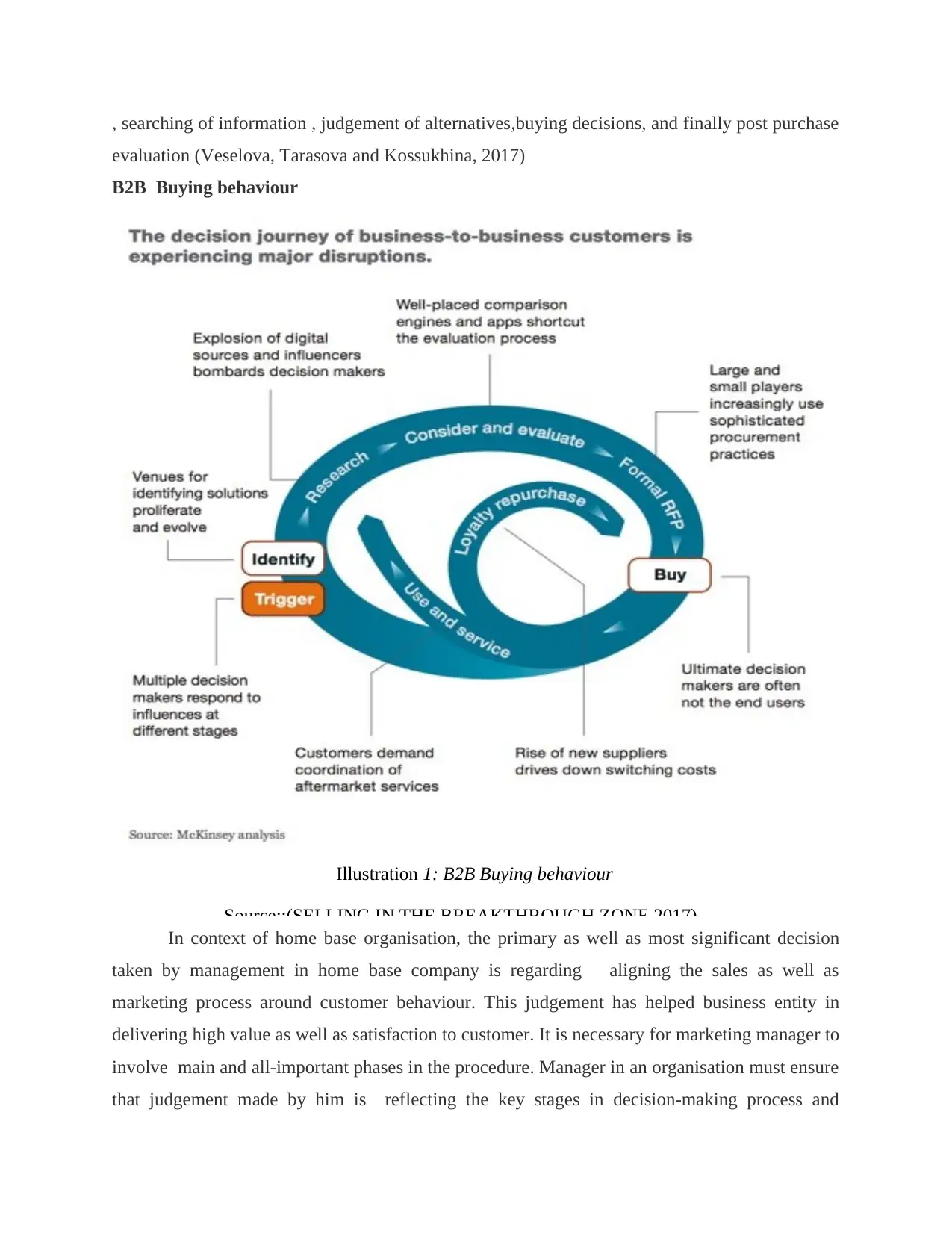
, searching of information , judgement of alternatives,buying decisions, and finally post purchase
evaluation (Veselova, Tarasova and Kossukhina, 2017)
B2B Buying behaviour
Illustration 1: B2B Buying behaviour
Source::(SELLING IN THE BREAKTHROUGH ZONE,2017)
In context of home base organisation, the primary as well as most significant decision
taken by management in home base company is regarding aligning the sales as well as
marketing process around customer behaviour. This judgement has helped business entity in
delivering high value as well as satisfaction to customer. It is necessary for marketing manager to
involve main and all-important phases in the procedure. Manager in an organisation must ensure
that judgement made by him is reflecting the key stages in decision-making process and
evaluation (Veselova, Tarasova and Kossukhina, 2017)
B2B Buying behaviour
Illustration 1: B2B Buying behaviour
Source::(SELLING IN THE BREAKTHROUGH ZONE,2017)
In context of home base organisation, the primary as well as most significant decision
taken by management in home base company is regarding aligning the sales as well as
marketing process around customer behaviour. This judgement has helped business entity in
delivering high value as well as satisfaction to customer. It is necessary for marketing manager to
involve main and all-important phases in the procedure. Manager in an organisation must ensure
that judgement made by him is reflecting the key stages in decision-making process and
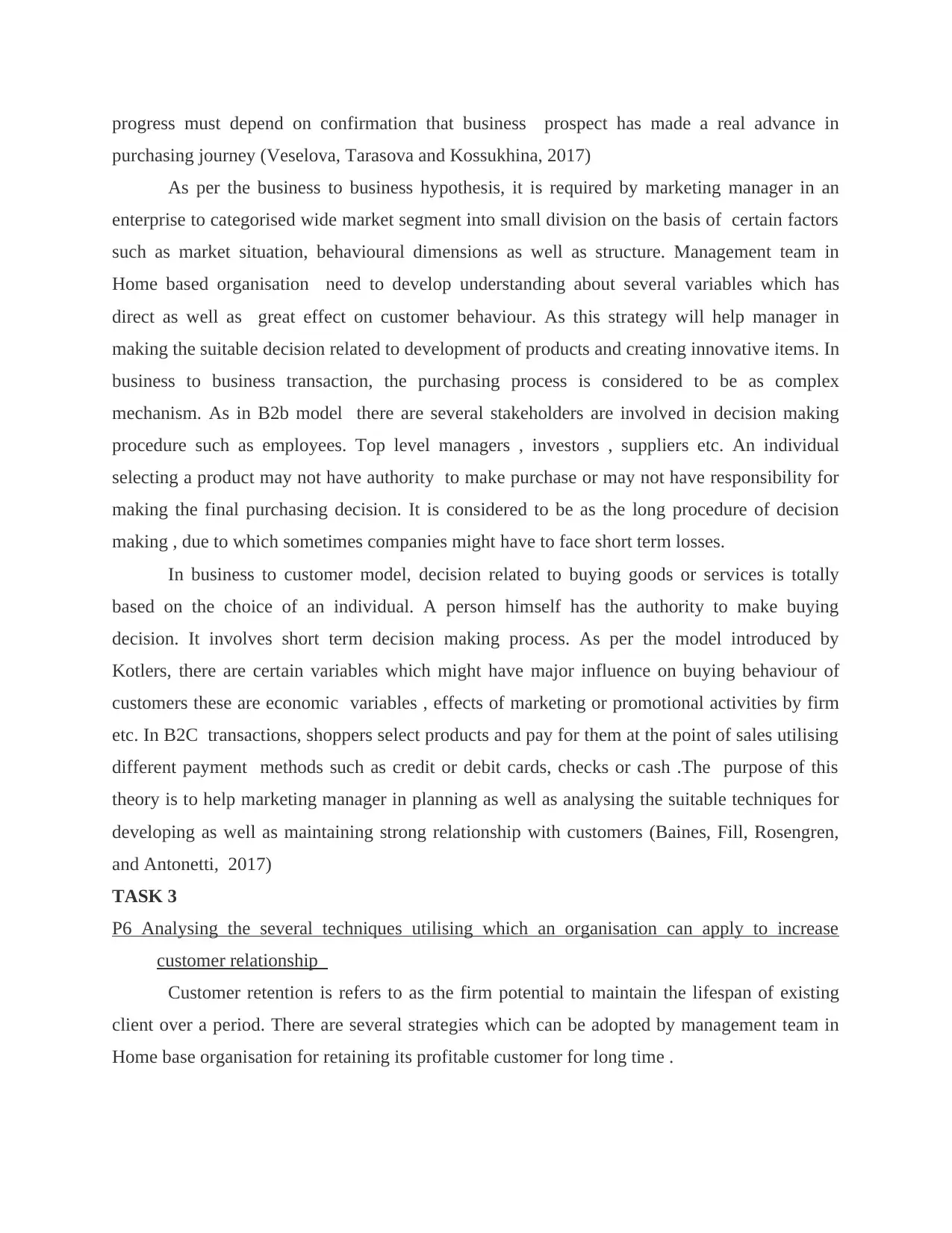
progress must depend on confirmation that business prospect has made a real advance in
purchasing journey (Veselova, Tarasova and Kossukhina, 2017)
As per the business to business hypothesis, it is required by marketing manager in an
enterprise to categorised wide market segment into small division on the basis of certain factors
such as market situation, behavioural dimensions as well as structure. Management team in
Home based organisation need to develop understanding about several variables which has
direct as well as great effect on customer behaviour. As this strategy will help manager in
making the suitable decision related to development of products and creating innovative items. In
business to business transaction, the purchasing process is considered to be as complex
mechanism. As in B2b model there are several stakeholders are involved in decision making
procedure such as employees. Top level managers , investors , suppliers etc. An individual
selecting a product may not have authority to make purchase or may not have responsibility for
making the final purchasing decision. It is considered to be as the long procedure of decision
making , due to which sometimes companies might have to face short term losses.
In business to customer model, decision related to buying goods or services is totally
based on the choice of an individual. A person himself has the authority to make buying
decision. It involves short term decision making process. As per the model introduced by
Kotlers, there are certain variables which might have major influence on buying behaviour of
customers these are economic variables , effects of marketing or promotional activities by firm
etc. In B2C transactions, shoppers select products and pay for them at the point of sales utilising
different payment methods such as credit or debit cards, checks or cash .The purpose of this
theory is to help marketing manager in planning as well as analysing the suitable techniques for
developing as well as maintaining strong relationship with customers (Baines, Fill, Rosengren,
and Antonetti, 2017)
TASK 3
P6 Analysing the several techniques utilising which an organisation can apply to increase
customer relationship
Customer retention is refers to as the firm potential to maintain the lifespan of existing
client over a period. There are several strategies which can be adopted by management team in
Home base organisation for retaining its profitable customer for long time .
purchasing journey (Veselova, Tarasova and Kossukhina, 2017)
As per the business to business hypothesis, it is required by marketing manager in an
enterprise to categorised wide market segment into small division on the basis of certain factors
such as market situation, behavioural dimensions as well as structure. Management team in
Home based organisation need to develop understanding about several variables which has
direct as well as great effect on customer behaviour. As this strategy will help manager in
making the suitable decision related to development of products and creating innovative items. In
business to business transaction, the purchasing process is considered to be as complex
mechanism. As in B2b model there are several stakeholders are involved in decision making
procedure such as employees. Top level managers , investors , suppliers etc. An individual
selecting a product may not have authority to make purchase or may not have responsibility for
making the final purchasing decision. It is considered to be as the long procedure of decision
making , due to which sometimes companies might have to face short term losses.
In business to customer model, decision related to buying goods or services is totally
based on the choice of an individual. A person himself has the authority to make buying
decision. It involves short term decision making process. As per the model introduced by
Kotlers, there are certain variables which might have major influence on buying behaviour of
customers these are economic variables , effects of marketing or promotional activities by firm
etc. In B2C transactions, shoppers select products and pay for them at the point of sales utilising
different payment methods such as credit or debit cards, checks or cash .The purpose of this
theory is to help marketing manager in planning as well as analysing the suitable techniques for
developing as well as maintaining strong relationship with customers (Baines, Fill, Rosengren,
and Antonetti, 2017)
TASK 3
P6 Analysing the several techniques utilising which an organisation can apply to increase
customer relationship
Customer retention is refers to as the firm potential to maintain the lifespan of existing
client over a period. There are several strategies which can be adopted by management team in
Home base organisation for retaining its profitable customer for long time .
⊘ This is a preview!⊘
Do you want full access?
Subscribe today to unlock all pages.

Trusted by 1+ million students worldwide
1 out of 15
Related Documents
Your All-in-One AI-Powered Toolkit for Academic Success.
+13062052269
info@desklib.com
Available 24*7 on WhatsApp / Email
![[object Object]](/_next/static/media/star-bottom.7253800d.svg)
Unlock your academic potential
Copyright © 2020–2025 A2Z Services. All Rights Reserved. Developed and managed by ZUCOL.





